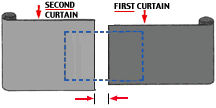Focal-plane shutter
is very close to the surface of the film. Focal plane shutters were very popular
during the seventies. In the late seventies and early part of '80, there are many
midrange SLR models have converted to use vertically traveled shutter curtains but
most professional class SLR cameras like the Nikon
F3 (1980),
New Canon
F-1(1981),
Pentax
LX(1980),
Olympus OM-3 &4 (1983) and the Contax
RTS II
(1982) etc. All these top rated SLRs were using horizontal traveled shutter mechanism
instead of vertical traveled shutter design. It was a general belief that such shutter
were more durable and reliable. However, horizontal traveled shutter has a major
drawback in its sync speed which often limiting to around 1/60 - 1/90 sec sync speed
for flash photography. due to the focal-plane shutter travels horizontally which
means it has go closes across the long dimension of the picture frame of 35mm format
(36mm x 24mm). The illustrations
followed shows the flow chart in operation of a two-curtain focal-plane shutter which
travels horizontally. When exposure time begins, the first curtain is released to
start its travel. As it moves, the first curtain passes across the film frame, allowing
light to fall on the film. When the first curtain has completed its travel, the frame
is fully opened. When exposure time ends, the second curtain is released to begin
its travel and close off light to the film.
 |
Basic construction is comprised of two opaque curtains are mounted on rollers. Normally, the first curtain is positioned so it covers up the surface of the film and does not allow light to reach it. Shutter materials ranges from Titanium for higher end models to silk/cloth for midrange models. |
Popular SLRs of he '70 such as Canon A-Series models Canon A-1, AE-1 PROGRAM or the Olympuses like OM-1, 2n, 3 and 4 are some examples that are using silk fabric as the prime materials for their shutter curtain.
Some
useful references
relates to Shutter in this PIM site: Vertically traveled Copal
Shutter
used in Nikkormat
FT-3 and
EL2; Honeycomb
Titanium shutter
curtain used in Nikon
FA, FM2, FE2. EMAS
shutter
used in the Canon
T-70 &
T-50, the
Titanium shutter
mechanism
designed for the New
Canon F-1.
(1 ) Ready to
make an exposure. Film frame is covered by first curtain.
 |
(2) First curtain begins to travel across frame, opening frame to image from lens. To make an exposure, the first curtain travels from one roller to the other. The first curtain moves across the film frame and stops at a location that leaves the frame open to receive light from the lens. |
 |
(3) First curtain travel completed. The entire film frame is exposed to light. |
 |
(3) When the desired time of exposure is ended, it releases the second curtain and it begins to travel across the picture frame, the second curtain moves from roller to roller and covers the film frame, closing frame to image from the lens and ends the exposure. |
 |
(5) When the second curtain travel completed. Film frame cover and shielded by second curtain. Exposure is thus completed. Advancing film to next frame resets shutter and ready to make another exposure. |
 If a selected exposure time is short (or fast shutter speed), second curtain "chases" first curtain across frame and exposure is through a narrow traveling slit between the two curtains. The second curtain follows so closely behind the first curtain that the entire frame could never open to light all at the same time. |
For a fast shutter speed or a very short exposure time such as 1/500 sec or 1/2000 sec, the first curtain will not have traveled very far before the second curtain starts chasing it across the frame. The film frame will be exposed by a narrow traveling slit of light formed by the gap between the two curtains. At no time is the complete film frame exposed all at once to light from the lens. For most picture-taking situations, it doesn't matter that the frame was exposed by a traveling slit of light. |
How about working with flash in a horizontal traveled focal plane shutter ? Honestly, when shooting with flash, a focal plane shutter is at a disadvantage. To use electronic flash with a focal-plane shutter, a shutter speed must be selected so the first curtain reaches the end of its travel and then a brief instant passes before the second curtain begins its journey across the frame. During that brief instant, all of the frame is open to light and it closes the electrical contacts for X sync and fires the flash instantly and that is how a flash occurs. This means the exposure time selected on the shutter-speed dial must be slightly longer than the time required for the first curtain to travel across the frame. Horizontally moving shutters travel across the wide dimension of the frame-36mm. Vertical shutters travel across the narrow dimension of the frame-24mm. The longer shutter curtain traveling time required makes the maximum sync slower. X-sync is the fastest shutter speed that will synchronize with electronic flash. For an instance, all Canon A-series models use horizontal shutter and thus they can provide a relatively slow maximum sync speed of 1/60 sec; the professional grade body of New F-1, also employed with horizontal traveled shutter is marginally higher at 1/90 sec. but it was the fastest among its class.
 An illustration at the top is an example of 'out-of-sync' shutter speed in flash photography where portion of the image is not being exposed due to improper synchronization of flash. |
OFF TOPIC SUPPLEMENTS: The Canon T-series that followed achieved a higher 1/90 sec for T-70, the autofocus T-80, but the entry level T-50 has an equivalent speed as the A-series of 1/60 sec; however, the impressively full spec T-90 has the highest sync speed among all the manual focus Canon bodies in 1/250 sec and also provide TTL OTF flash exposure control with a dedicated 300TL Speedlite |
But what is it got to do with flash photography ?
With a horizontal traveled shutter design such as the Nikon F3. Olympus OM2(n), OM3 or OM4 bodies or even the Pentax LX which featured TTL OTF flash exposure control with their respective dedicated flash units, the first curtain is released to make an exposure, and the second curtain follows behind at a time interval equal to the desired length of exposure. When the first curtain reaches the end of its travel, the film frame is uncovered as far as the first curtain is concerned, so it closes the electrical contacts for X-sync and fires the flash. If the second curtain is following closely behind the first, at 1/500 second for example, part of the frame will already have been covered up by the second curtain at the instant of the flash. The only part of the frame that could be exposed is the narrow slit between the two curtains. Electronic flash with a focal plane shutter requires exposure at X-sync, or slower. But the actual time of exposure due to the bright light of the flash is very much shorter - 1/500 second down to as little as 1/50,000 second or less in some cases. If there is enough illumination on the scene from sources other than the flash - called "Ambient Light" - to cause some exposure during the full time the shutter is open, then there are two exposures: one short-time exposure due to the short duration of the flash and another longer-time exposure due to the ambient light on the scene. This is especially true for synchro-sunlight photography in situation such as fill-in flash. If the subject moves during the time the shutter is open, or the camera moves, the image due to ambient light will not be in register with the image due to flash. This can cause a blur or a faint "echo" of the subject on the film or more popularly known as "ghosting". But some use this to enhance or project a sense of movement for action flow flash photography.
Note: You
can use slower shutter speeds if you have specific reason to. At slower speeds, the
second curtain waits even longer before starting across the frame, so electronic
flash works OK.
As the SLR market now is dominated by camera that are using vertical traveled shutter
design, which offers significantly faster workable shutter sync speed, TTL metering
capability and amazing ultrahigh speed synchronization with FP (Focal Plane) sync
(Some SLRs such as Olympus OM-4Ti, Minolta 9xi, Nikon F5, F100 etc. can go as fast
as 1/4000 sec in the FP mode! ), but all these development are coincide with higher
achievable sync speed for flash resulting from development in shutter design and
thus eliminate some of these major weaknesses which closely associated with horizontal
focal plane shutter design that was once so popular.
| Back to | I am not so
sure where did you click in from...
Click the back button will bring you back to "Knowledge and Resources"
section or use the "Back" button on your browser's menu.
Home - Photography in Malaysia |